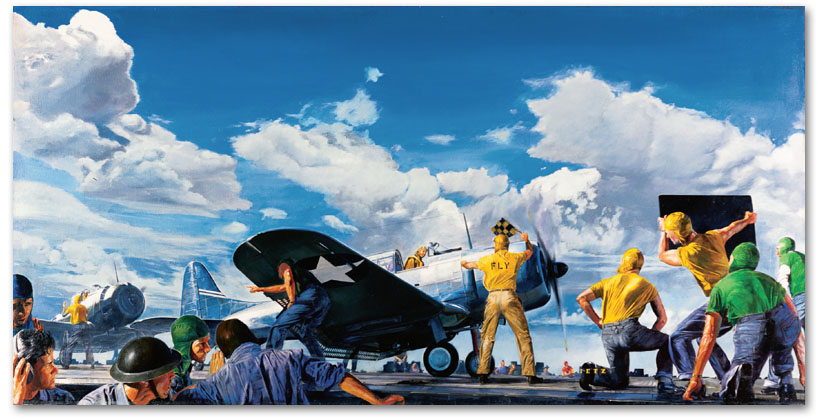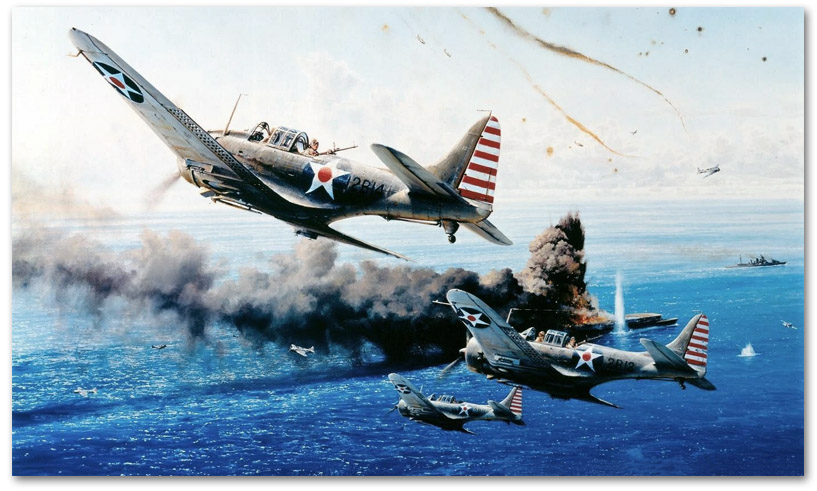|
Posted on 05/08/2003 5:34:33 AM PDT by SAMWolf
|
|
 are acknowledged, affirmed and commemorated.
|

| Our Mission: The FReeper Foxhole is dedicated to Veterans of our Nation's military forces and to others who are affected in their relationships with Veterans.
Where the Freeper Foxhole introduces a different veteran each Wednesday. The "ordinary" Soldier, Sailor, Airman or Marine who participated in the events in our Country's history. We hope to present events as seen through their eyes. To give you a glimpse into the life of those who sacrificed for all of us - Our Veterans.
|
|
|
|
The Battle of the Coral Sea John James Powers, born in New York City 3 July 1912, graduated from the Naval Academy in 1935. After serving at sea for 5 years, he underwent flight training, reporting 21 January 1941 to Bombing Squadron 5, attached to famed Yorktown (CV-5).  Next morning while the great carrier battle continued, he joined the attack on Shokaku, scoring an important bomb hit. His intrepid, low-bombing run, however, brought Powers into heavy antiaircraft fire and his plane plunged into the sea. Lt. Powers was declared dead; but, for his indomitable spirit in this series of attacks, was awarded the Medal of Honor posthumously. According to the citation: "... completely disregarding the safety altitude and without fear or concern for his own safety, he courageously pressed home his attack, almost to the very deck of an enemy carrier and did not release his bomb until he was sure of a direct hit." Congressional Medal of Honor Awarded Posthumously JOHN JAMES POWERS Rank and organization: Lieutenant, U.S. Navy. Born: 13 July 1912, New York City, New York. Accredited to: New York. Other Navy award: Air Medal with 1 gold star. For distinguished and conspicuous gallantry and intrepidity at the risk of his life above and beyond the call of duty, while pilot of an airplane of Bombing Squadron 5, Lt. Powers participated, with his squadron, in five engagements with Japanese forces in the Coral Sea area and adjacent waters during the period 4 to 8 May 1942.  Three attacks were made on enemy objectives at or near Tulagi on 4 May. In these attacks he scored a direct hit which instantly demolished a large enemy gunboat or destroyer and is credited with two close misses, one of which severely damaged a large aircraft tender, the other damaging a 20,000-ton transport. He fearlessly strafed a gunboat, firing all his ammunition into it amid intense antiaircraft fire. This gunboat was then observed to be leaving a heavy oil slick in its wake and later was seen beached on a nearby island. On 7 May, an attack was launched against an enemy airplane carrier and other units of the enemy's invasion force. He fearlessly led his attack section of three Douglas Dauntless dive bombers, to attack the carrier. On this occasion he dived in the face of heavy antiaircraft fire, to an altitude well below the safety altitude, at the risk of his life and almost certain damage to his own plane, in order that he might positively obtain a hit in a vital part of the ship, which would insure her complete destruction. This bomb hit was noted by many pilots and observers to cause a tremendous explosion engulfing the ship in a mass of flame, smoke, and debris. The ship sank soon after. That evening, in his capacity as Squadron Gunnery Officer, Lt. Powers gave a lecture to the squadron on point-of-aim and diving technique. During this discourse he advocated low release point in order to insure greater accuracy; yet he stressed the danger not only from enemy fire and the resultant low pull-out, but from own bomb blast and bomb fragments. Thus his low-dive bombing attacks were deliberate and premeditated, since he well knew and realized the dangers of such tactics, but went far beyond the call of duty in order to further the cause which he knew to be right.  The next morning, 8 May, as the pilots of the attack group left the ready room to man planes, his indomitable spirit and leadership were well expressed in his own words, "Remember the folks back home are counting on us. I am going to get a hit if I have to lay it on their flight deck." He led his section of dive bombers down to the target from an altitude of 18,000 feet, through a wall of bursting antiaircraft shells and into the face of enemy fighter planes. Again, completely disregarding the safety altitude and without fear or concern for his safety, Lt. Powers courageously pressed home his attack, almost to the very deck of an enemy carrier and did not release his bomb until he was sure of a direct hit. He was last seen attempting recovery from his dive at the extremely low altitude of 200 feet, and amid a terrific barrage of shell and bomb fragments, smoke, flame and debris from the stricken vessel.
|
Yep. It's true. She considers Indianapolis "home" since she lived there the longest time of all the places we lived. Military family ya know. So, all her high school and college friends (and boyfriend!!!) are there. She will go back to Indiana University and has decided to major in Nursing. So, she'll be on the Indianapolis campus, which is good because we lived in Indy and she likes it better than Bloomington. I'll miss her so much. *sniffle*
|
Honoring the Dead Past and Present
 American soldiers secure a British flag to a flagpole using plastic handcuffs after a ceremony marked the reclamation of a World War I British Army cemetery, in Al Kut, south central Iraq, Thursday, May 8, 2003. Hundreds of British soldiers who died during the campaign for Mesopotamia were buried in the cemetery, but the site fell into disprepair and obscurity under the Saddam Hussein regime, becoming a makeshift trash dump. (AP Photo/Brennan Linsley).  Lance Corporal Andy Wright, from the Scottish regiment Blackwatch, plays the bagpipes at a small gathering of British and U.S. troops to rededicate a war cemetery to 420 soldiers from British forces killed during the 1916 siege of Kut, south of Baghdad, May 8, 2003  A U.S. officer addresses a small gathering of British and U.S. troops at the rededication of a war cemetery to 420 soldiers from British forces killed during the 1916 siege of Kut, south of Baghdad, May 8, 2003.  A U.S. officer looks at a headstone after a gathering of British and U.S. troops at the rededication of a war cemetery to 420 soldiers from British forces killed during the 1916 seige of Kut, south of Baghdad May 8, 2003.  British Army Chaplain Maj. Gen. John Blackburn, left, and Queen's Bishop David O'Connor, Duke of Windsor, lead a memorial service during ceremonies marking the reclamation of a World War I British Army cemetery, in Al Kut, south central Iraq, Thursday, May 8, 2003  British Army Lance Cpl Andy Wright plays a song during a memorial ceremony which marked the reclamation of a World War I British Army cemetery, in Al Kut, south central Iraq, Thursday, May 8, 2003.  British commander, Maj. Gen. Robin Brims shakes hands with an Iraqi official invited to attend ceremonies marking the reclamation of a World War I British Army cemetery, in Al Kut, south central Iraq, Thursday, May 8, 2003. U.S. Marine Gen. Rich Natonski, looks on in the center.  British commander, Maj. Gen. Robin Brims, takes a close look at a British Army headstone, after he attended ceremonies marking the reclamation of a World War I British Army cemetery, in Al Kut, south central Iraq, Thursday, May 8, 2003.  British Bishop David Conner, Dean of Windsor, walks through the Kut war cemetery after a small gathering of British and U.S. troops rededicated it to the 420 soldiers from British forces killed during the 1916 siege of Kut, south of Baghdad, May 8, 2003.
|



Disclaimer: Opinions posted on Free Republic are those of the individual posters and do not necessarily represent the opinion of Free Republic or its management. All materials posted herein are protected by copyright law and the exemption for fair use of copyrighted works.